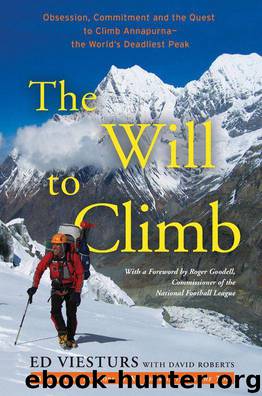The Will to Climb: Obsession and Commitment and the Quest to Climb Annapurna--the World's Deadliest Peak by Viesturs Ed & Roberts David

Author:Viesturs, Ed & Roberts, David [Viesturs, Ed]
Language: eng
Format: mobi, epub
ISBN: 9780307720443
Publisher: Random House, Inc.
Published: 2011-10-03T20:00:00+00:00
SIX
MESSNER AND KUKUCZKA
In October 1986, when he topped out on Lhotse, Reinhold Messner became the first person to climb all fourteen 8,000-meter peaks. Curiously, though, he claimed that it was not until 1982, by which point he had reached the summit of nine of them, that he even conceived of the goal of bagging all fourteen. In his memoir about that campaign, All 14 Eight-Thousanders, he insists that if by 1982 “closing the loop” had become for him a goal, “it was only a secondary one. Climbing increasingly harder routes, setting myself new targets, was of far greater importance to me.”
Messner also appears to have been the first person to set himself this challenge. Before the early 1980s a project such as that seemed unthinkable. It was hard enough (and costly enough, in an age before mountaineers commanded full-time sponsorship) simply to get up any 8,000er. During the so-called Golden Age of Himalayan Mountaineering, between 1950 and 1964, when the first ascents of all fourteen were accomplished, only two men—Hermann Buhl and Kurt Diemberger, both Austrians—participated in the first ascent of more than a single 8,000er. Buhl reached the top of Nanga Parbat alone in 1953, and four years later shared his triumph on Broad Peak with Diemberger, who in 1960 was one of the three men who first reached the summit of Dhaulagiri. (Lionel Terray came close, having topped out on Makalu in 1955, five years after selflessly giving up his chance at summiting on Annapurna to work in support of Herzog and Lachenal.)
It was not until 1975 that any man reached the summit of three 8,000ers. That man, not surprisingly, was Messner, who had succeeded on Nanga Parbat and Manaslu before adding Gasherbrum I to his list. The 1975 climb of Gasherbrum I, marking only the second ascent of the peak (eighteen years after an American team first climbed it), was a Himalayan breakthrough, as Messner and Peter Habeler tackled the eleventh highest mountain in the world without porter or Sherpa support up high and in true alpine style.
As mentioned in the previous chapter, by 1984 the competition to become the first to nail all fourteen 8,000ers had evolved into a genuine race—no matter that all five leading candidates insisted that they were not involved in the race. It took Messner sixteen years to close his own loop. Meanwhile, the remarkable Polish climber Jerzy Kukuczka turned on the jets of his ambition and got up all fourteen in the span of only eight years. He lost out in the race with Messner by a mere eleven months.
Eight years later, Erhard Loretan was surprised that anyone would give a damn if he became the third man to close the loop. But his head-to-head competition with Benoît Chamoux to claim that honor climaxed in the dramatic and tragic events on Kangchenjunga in 1995, as recounted in chapter 5.
Nor did Loretan’s achievement discourage the next men in line. The year after Loretan completed his round, the Mexican Carlos Carsolio became the fourth to accomplish the feat, and the Pole Krzysztof Wielicki became the fifth.
Download
The Will to Climb: Obsession and Commitment and the Quest to Climb Annapurna--the World's Deadliest Peak by Viesturs Ed & Roberts David.epub
This site does not store any files on its server. We only index and link to content provided by other sites. Please contact the content providers to delete copyright contents if any and email us, we'll remove relevant links or contents immediately.
| Camping | Excursion Guides |
| Instructional | Walking |
In a Sunburned Country by Bill Bryson(3371)
Annapurna by Maurice Herzog(3301)
How to Read Nature by Tristan Gooley(3081)
Dangerous Girls by Haas Abigail(2841)
SAS Survival Handbook by John 'Lofty' Wiseman(2583)
The Lost Art of Reading Nature's Signs by Tristan Gooley(2549)
In the Woods by Tana French(2417)
The Stranger in the Woods by Michael Finkel(2329)
Food and Water in an Emergency by Food & Water In An Emergency(2273)
Guns, Germs and Steel by Diamond Jared(2201)
Wild: From Lost to Found on the Pacific Crest Trail by Cheryl Strayed(2133)
Everest the Cruel Way by Joe Tasker(2133)
Backpacker the Complete Guide to Backpacking by Backpacker Magazine(2111)
Trail Magic by Trevelyan Quest Edwards & Hazel Edwards(2063)
Ultimate Navigation Manual by Lyle Brotherton(2054)
Sea Survival Handbook by Keith Colwell(2044)
Welcome to the Goddamn Ice Cube by Blair Braverman(1887)
Birds of the Pacific Northwest by Shewey John; Blount Tim;(1875)
The Last Flight by Julie Clark(1832)
